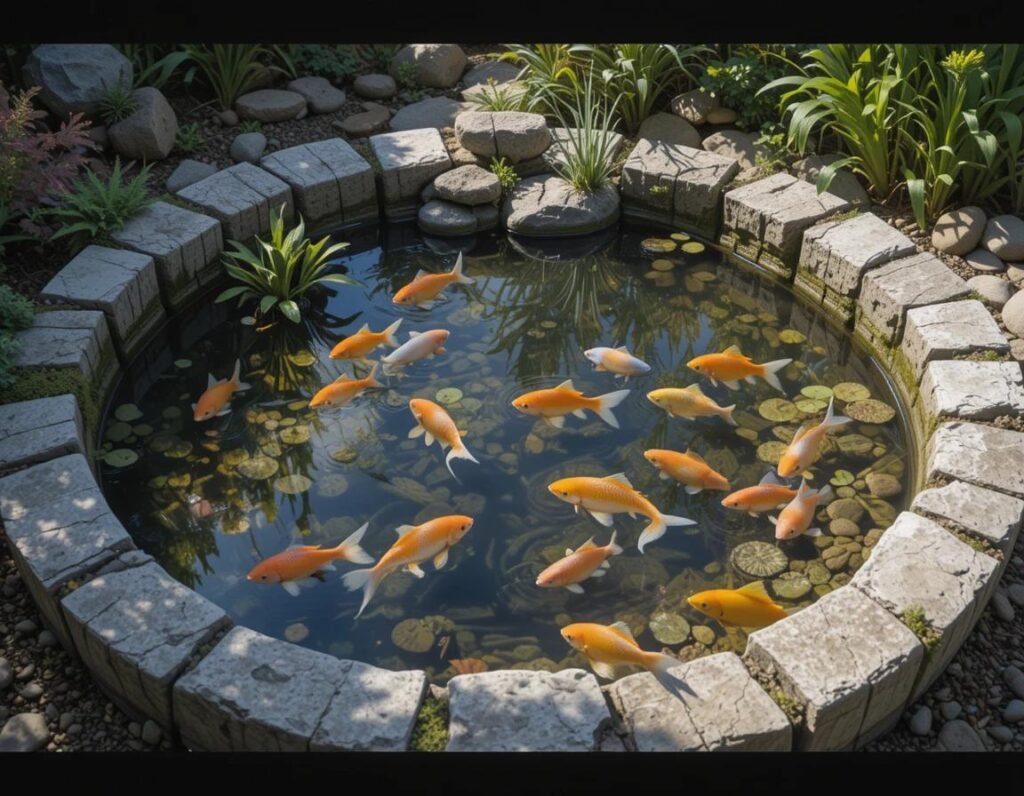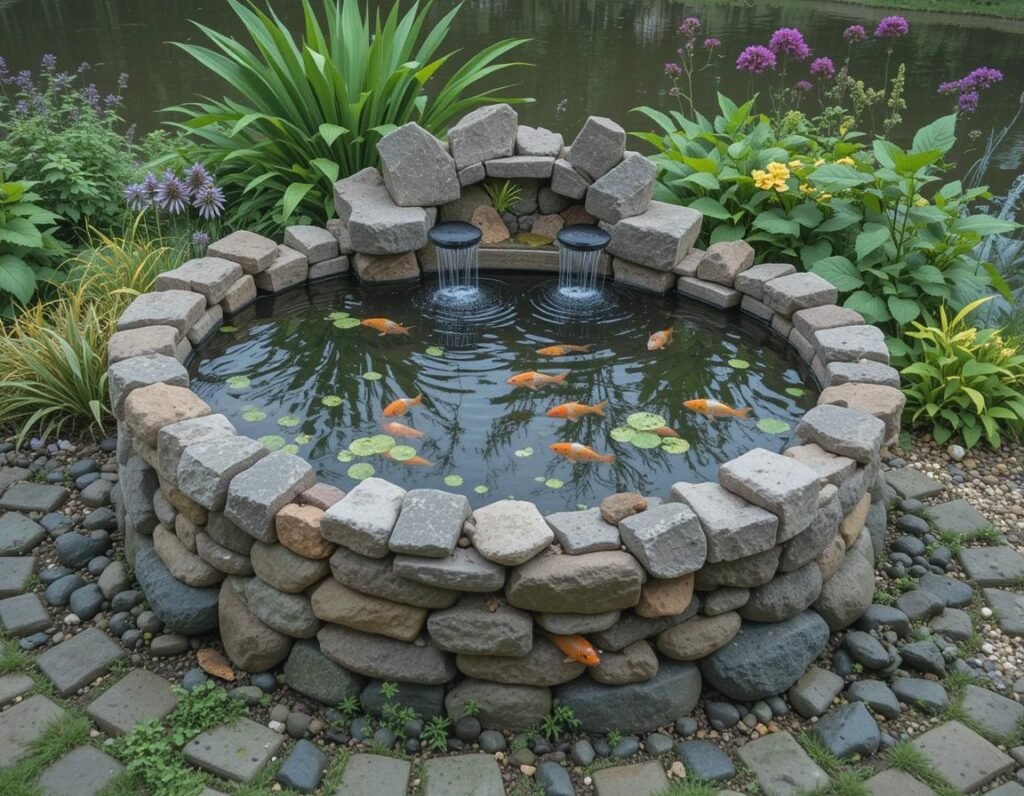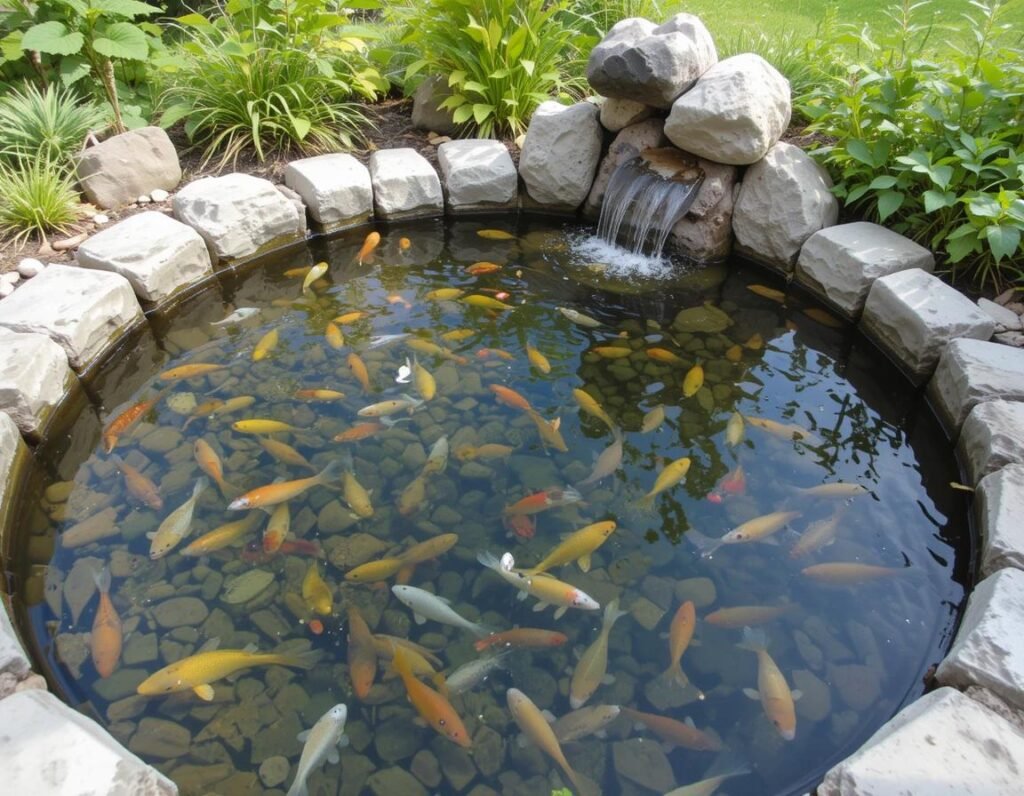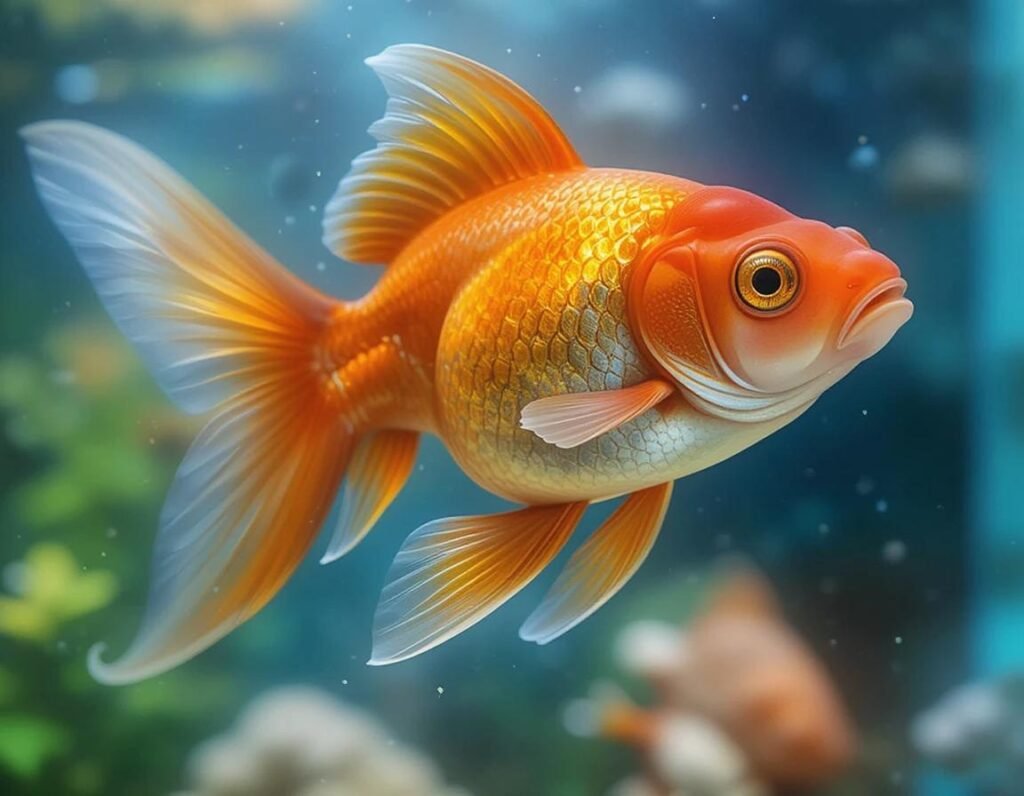
If you’ve ever daydreamed about having a serene goldfish pond in your backyard, you’re not alone. There’s something magical about watching your goldfish glide gracefully through crystal-clear water, surrounded by lush plants and maybe even a decorative fountain. It’s like a tiny, watery oasis right outside your door.
But hold up before you start digging a hole and tossing in some fish. Setting up a goldfish pond requires a little more than just water and goldfish food. Don’t worry though—we’ve got you covered. Here’s a simple and easy guide to help you get your goldfish pond up and running smoothly, with some added humor to keep things light.
Step 1: Choosing the Right Location for Your Goldfish Pond
Location is key! You don’t want your goldfish pond to be in a shady spot (unless you want your fish to rock some serious sunburns). Ideally, you want your pond to get some sunlight—but not too much, because then your pond could turn into a swampy mess faster than you can say “goldfish crackers.”
- Pick a sunny spot: About 4-6 hours of sunlight a day is ideal for goldfish.
- Avoid strong winds: Fish don’t appreciate gale-force winds blowing through their watery kingdom, so try to find a spot that’s sheltered.
- Accessibility: You’ll need to maintain your pond, so make sure it’s easy to reach (without tripping over your garden gnomes).
Step 2: Digging the Pond and Creating Depth
When it comes to digging your pond, don’t just go with a shallow puddle of water. Goldfish need some space to grow, and they don’t want to feel cramped. Plus, deeper ponds help maintain better water quality. Here’s what you need to know:
- Depth matters: A good pond depth is at least 2 feet. This allows your goldfish to have enough room to swim, hide, and stay cooler in the summer.
- Sloping sides: Make sure your pond has gradual slopes so the goldfish can easily get in and out (they’re not Olympians when it comes to jumping).
- Shape it up: The shape of your pond doesn’t matter as long as you’re creating enough space for both fish and plants. You can go for round, oval, or freeform.
Step 3: Installing the Pond Liner
Now that you’ve got your hole ready, it’s time to lay down the pond liner. This is the protective layer that keeps your pond from leaking water everywhere.
- Choose a high-quality liner: Go for something durable, like EPDM rubber or PVC, to prevent tears and leaks.
- Make sure it fits: Lay the liner inside the pond, making sure it’s large enough to cover the entire area and have some overlap around the edges.
- Secure it: Use rocks or bricks to weigh down the edges of the liner so it doesn’t shift or move.
Pro tip: If your pond’s edges look a little too obvious with the liner showing, you can hide it with some decorative rocks, plants, or mulch. It’s like giving your pond a stylish makeover!
Step 4: Adding Water and Filtration System
Goldfish are messy eaters, and they love to produce waste, which means your pond needs an efficient filtration system. Not only will it help keep the water clear, but it will also keep your fish from swimming in their own “leftovers” all the time.
- Install a filter: A good filtration system will help remove waste and keep your pond healthy. Make sure you get a filter that’s suited for the size of your pond.
- Add water: Fill the pond with water. If you’re using tap water, make sure to treat it with a water conditioner to remove chlorine, which can harm your fish.
- Let the water sit: Before introducing your goldfish to their new home, let the water sit for a few days to ensure it’s safe and the filter is working well.
Step 5: Pond Plants and Decorations
Goldfish love plants—they’ll nibble on them, hide in them, and swim around them like they’re doing their best Aquarium Olympics routine. So, adding plants to your pond isn’t just for aesthetics; it’s for their enjoyment too!
- Floating plants: Water lilies and duckweed provide shade and oxygen for your fish. Plus, they’re pretty to look at.
- Submerged plants: Plants like anubias and hornwort help keep the water clean by absorbing excess nutrients.
- Rocks and caves: Goldfish love hiding in crevices. Add some rocks, or even a small pond cave, where your fish can chill out and feel safe.
Warning: Avoid plants that are too delicate or might get uprooted easily—goldfish can be a bit rough on their greenery.

Step 6: Introducing Your Goldfish
It’s finally time to introduce your goldfish to their new home. But don’t just toss them in willy-nilly. You’ll want to make sure the pond is ready and that your goldfish transition smoothly.
- Acclimate your goldfish: Before letting your fish swim freely, put them in a net or bag and float them in the pond for 15-20 minutes. This helps them adjust to the temperature.
- Don’t overcrowd: Give your goldfish plenty of room. It’s tempting to throw in all your fish at once, but remember, a little space goes a long way.
- Check water conditions regularly: Keep an eye on the pH, ammonia, and nitrate levels to make sure the water stays healthy.
Step 7: Ongoing Maintenance and Care
Now that your goldfish pond is set up, it’s important to maintain it so your fish stay happy and healthy.
- Regular water changes: Do small water changes of 10-20% weekly to keep things clean.
- Filter cleaning: Clean the filter regularly (about once a month), but don’t clean it all at once, as beneficial bacteria need time to recover.
- Monitor fish health: Keep an eye on your goldfish for signs of stress or disease, and make sure they have enough food but not too much.
Pro tip: If the pond gets a little too dirty or algae starts taking over, don’t panic. It happens. You can install a pond UV sterilizer to keep algae in check and improve water clarity.
Step 8: Seasonal Care for Your Goldfish Pond
Depending on where you live, your goldfish pond will experience changes with the seasons. Don’t worry; your goldfish are tough little creatures, but you’ll still need to adjust your care routine to keep them safe year-round. Here’s how to keep your pond in tip-top shape for all seasons:
In Spring and Summer
- Watch for algae blooms: Warm weather often leads to algae growth. While some algae is natural, excessive algae can cause oxygen levels to drop, which isn’t good for your fish. A UV filter or pond skimmer can help clear things up.
- Ensure proper oxygenation: As the pond heats up, the oxygen levels might drop. You can add an aerator or a small fountain to keep the water oxygen-rich for your fish.
- Check for pests: Insects and other critters love ponds too, but be on the lookout for anything that might harm your goldfish or pond plants. Removing fallen leaves and debris can help prevent rotting and keep your fish from nibbling on unwanted guests.
In Fall
- Prepare for cooler weather: As temperatures start to dip, you’ll want to ensure your pond is ready for the colder months. If you live in an area where frost or freezing happens, you’ll need to protect your goldfish and the pond.
- Cover the pond: A pond cover or netting can prevent leaves from falling into the water. This also helps reduce debris and stops your goldfish from getting caught in falling debris.
- Start feeding less: As the weather cools, goldfish become less active and won’t need as much food. You can reduce feeding to once a day or every other day.
In Winter
- Monitor water temperature: If your pond freezes over, your goldfish may go into a kind of hibernation. If you’re in a cold climate, keep part of the pond unfrozen using a pond heater or a de-icer to allow gases to escape.
- Stop feeding your goldfish: Once the water temperature drops below 50°F (10°C), goldfish go into a resting state and won’t eat. Stop feeding them to avoid uneaten food building up in the pond, which can pollute the water.
- Insulate the pond: If your pond is shallow, you may need to insulate the sides to protect the fish from drastic temperature changes.
Step 9: Troubleshooting Common Goldfish Pond Problems
Goldfish ponds, like any water feature, might come with a few bumps along the way. Don’t fret! Most problems are fixable with a little know-how and patience. Here are a few common issues you might encounter:
1. Green, murky water
If your pond’s water turns green, it could be an algae bloom. While a little algae is normal, too much can cloud the water and harm your fish.
- Solution: Use a UV clarifier, and make sure your pond’s filter is doing its job. You can also add more plants to absorb excess nutrients that algae feed on.
2. Fish looking stressed or lethargic
Stressed fish are often a sign of poor water quality or overcrowding. Check your water parameters (pH, ammonia, nitrites, and nitrates).
- Solution: Perform a water change if necessary, and make sure the pond is adequately filtered. Also, avoid overfeeding your fish as leftover food can pollute the water.
3. Pond water smells bad
If your pond water has a bad odor, it’s usually due to decaying organic matter, like fallen leaves or leftover fish food.
- Solution: Clean out any debris regularly and consider using bacteria-based pond treatments to help break down organic matter naturally.
4. Fish are eating plants
Goldfish are well-known plant munchers, and if they’re nibbling on your carefully placed aquatic plants, don’t be surprised.
- Solution: Choose plants that are goldfish-friendly, such as Java fern, water lilies, and anubias, which are tough and can withstand a little nibbling.
Conclusion: Your Goldfish Pond Adventure Awaits!
Setting up and maintaining a goldfish pond may seem like a lot of work, but with a little planning and effort, it can become the centerpiece of your backyard—a place of tranquility, beauty, and endless fascination. Plus, you’ll have happy goldfish swimming in style, and who doesn’t love that?
So, grab your shovel, pick the perfect pond liner, and start planning your very own fishy paradise. And remember, the only thing better than watching your goldfish swim in their new pond is enjoying a cold drink while you sit back and relax by the water. Cheers to your new goldfish pond adventure—the fish are waiting!
FAQs About Goldfish Pond Setup
1. What size pond do I need for goldfish?
Answer: For one goldfish, a minimum of 20 gallons is recommended, but the more space, the better! If you plan to add more fish, aim for 10 additional gallons per fish. Goldfish love to swim and need room to grow, so make sure your pond is spacious enough for them to live comfortably.
2. Can I keep goldfish in a small pond?
Answer: While small ponds might look cute, they aren’t ideal for goldfish. A tiny pond will lead to poor water quality, and your goldfish may not have enough room to thrive. Aim for at least a 2-foot depth to give your goldfish room to swim and grow, and a pond size of at least 200 gallons if you plan to have a few fish.
3. Do goldfish need a pond filter?
Answer: Yes, absolutely! Goldfish are messy eaters, and they produce a lot of waste. A good filter is essential for maintaining clean water and keeping your goldfish healthy. A filter that’s rated for a pond size larger than yours will help keep the water in tip-top shape.
4. How do I prevent algae growth in my goldfish pond?
Answer: Algae blooms can be a common issue in goldfish ponds, but you can manage them with some clever tricks:
- Install a UV clarifier to keep the water clear.
- Add aquatic plants like water lilies or hornwort, which help absorb excess nutrients and shade the water.
- Don’t overfeed your goldfish, as excess food can contribute to algae growth.

5. What plants can I put in my goldfish pond?
Answer: Goldfish love plants, but they can be a bit nibbly. Go for hardy plants that can withstand a bit of goldfish chewing, like Java fern, water lilies, anubias, and water lettuce. These plants provide cover and oxygen, while also helping to keep your pond healthy.
6. Do I need to cover my goldfish pond?
Answer: If you live in an area with lots of leaves or debris, it’s a good idea to cover your pond with netting or a pond cover. This will keep the water clean and protect your fish from predators. In colder climates, you’ll also want to consider protecting your pond during winter with a cover to help prevent freezing.
7. How do I winterize my goldfish pond?
Answer: In colder climates, you’ll need to winterize your pond to keep your goldfish safe. Here are a few tips:
- Stop feeding your goldfish when the water temperature drops below 50°F (10°C).
- Use a de-icer to keep part of the pond surface from freezing, allowing gas exchange and keeping the fish oxygenated.
- Make sure the pond’s depth is at least 2 feet, so your fish have enough space to survive through the winter.
8. Can I keep goldfish with other pond fish?
Answer: Yes, goldfish are generally peaceful and can live with other cold-water species like shubunkins, white cloud minnows, or even koi (if you have a big enough pond). Avoid mixing goldfish with warm-water fish like bettas, as they have different temperature needs.
9. What should I do if my goldfish pond is dirty or smells bad?
Answer: If your pond water gets dirty or starts to smell, it could be a sign of excess waste or decaying plant matter. Try the following:
- Perform a partial water change (10-20%).
- Clean the pond filter and skimmer.
- Remove any dead plant matter or debris.
- Consider using bacteria treatments to help break down organic waste.
10. How do I know if my goldfish are happy in their pond?
Answer: Happy goldfish will:
- Swim actively and explore the pond.
- Have bright eyes and healthy fins.
- Interact with their surroundings, like swimming through plants or coming to the surface when you approach.
- Be peaceful with other fish in the pond.
If your goldfish are hiding, staying at the bottom, or not eating, it could be a sign of stress or illness, and it’s time to check water quality or pond conditions.
11. Can I build a DIY goldfish pond?
Answer: Yes, building a DIY goldfish pond is definitely possible! Just be sure to use the right materials, such as a pond liner and quality filtration system. There are plenty of tutorials online to guide you through the process, but be prepared for some hard work (and maybe a few muddy shoes).
12. How often should I change the water in my goldfish pond?
Answer: In general, you should change about 10-20% of the water weekly to keep things fresh. This helps maintain the balance of beneficial bacteria and prevents the buildup of harmful chemicals. You can adjust this frequency based on the pond size and number of fish. Don’t forget to test the water for ammonia, nitrite, and pH levels regularly.


